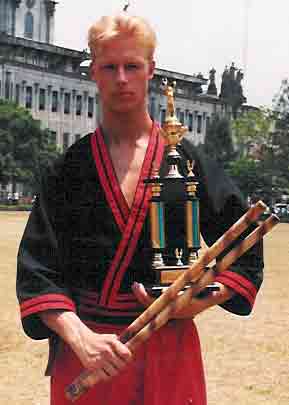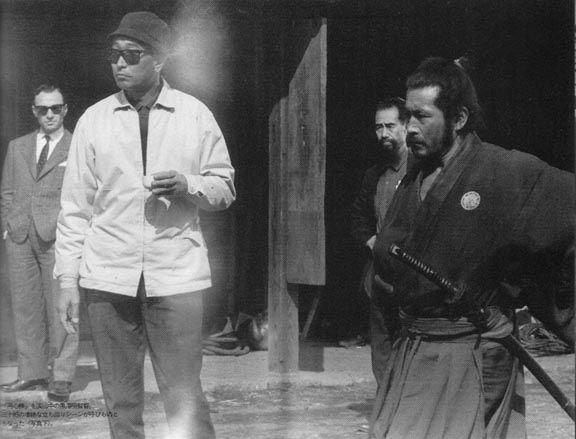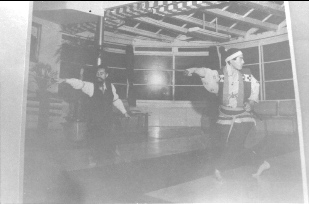SDKsupplies
The following article is the first part of an interview with Såzen Larsen Kusano Sensei (5th dan) of the Sugino branch of Katori Shinto Ryu. In this article, Såzen Sensei talks about his experiences in Katori Shinto Ryu. Those interested in learning more about Såzen Sensei can consult his group’s website: http://www.kakudokan.no/
Author’s
note: This interview was conducted on August 6, 2008 in Toronto,
Canada. Såzen (pronounced “Sozen”) Sensei came over
to Canada to conduct a special seminar in Katori Shinto Ryu.
Sensei: Thirteen years.
Question: How did you become involved with Katori Shinto Ryu?Sensei: Well, prior to going to Japan, I had seen an old video made by Panther Productions of an old man demonstrating a really old sword art. It was coincidentally Sugino Sensei doing a demonstration in Katori Shinto Ryu in California. I saw it and thought to myself, “That’s what I want to learn.”
By pure luck, I would eventually stumble upon the dojo years later. You see, I had a jujutsu teacher, the famous man named Wally Jay. I had expressed to him a wish, or my desire, to go to Japan to further study jujutsu seriously. So he told me, “Contact this person in Japan. He can help you.” That person was Patrick McCarthy, famous Canadian karate expert. So I contacted Pat and when I got to Japan, he helped me out quite a bit, getting familiar with everything, since at that time, he had already been there quite a few years.
Well, one day, he called me up to tell me he had a special appointment to see a really old master and why don’t you come along? Of course, I was all for meeting old masters. That was why I was in Japan!
You couldn’t imagine my surprise when we showed up at Sugino Dojo and the first person to greet me was the old master himself! That is how I first came into contact with Sugino Sensei.
Question: What do you remember of your first meeting with Yoshio Sugino Sensei?Sensei: When he greeted me at the door, I was speechless. He was very nice and talked a bit with me through the interpreter and asked me what I do. I told him jujutsu and told him about my other martial arts experiences.*
(* By the way, Såzen Sensei is an accomplished martial artist in other arts. He currently has a 5th dan in jujutsu, 3rd dan in aikido, 3rd dan in kyudo, 3rd dan in shorinji kempo. Before going to Japan, Såzen Sensei studied arnis in the Philippines under Grandmaster Ernesto Presas. On April 18th 1989, he represented Norway in the first Arnis World Championship that took place in Manila. 12 countries participated. He won the gold medal in forms, mens’ division.)

Såzen Sensei, World
Champion in Arnis. Manila,1989.
Question: What kind of man was Yoshio Sugino Sensei?
Sensei: What struck me most was that he controlled the room. He wasn’t the type of person to demand deep respect but he got it nonetheless.
He was very friendly. And also very accomodating. If you showed him that you wanted to learn, he would teach you.
He was also very balanced in his character. By this I mean, he could be strict, in a nice way. Like a schoolteacher, he knew what you needed. This is what you need and he would point it out. But even in doing this, he was very kind. He corrected you when it needed to be corrected.
And he was very patient. He always taught with great patience and slowly gave us the proper corrections and adjustments, bit by bit. He would say “mo ichi do”, meaning one more time. There was always one more time. I remember that he would watch us practice, watch our technique, even if it was bad or good, and he would stroke his long, white beard, in deep contemplation. He also encouraged us. He smiled a lot. And he always nodded and smiled when we gave a good effort and showed good spirit*.
(* i.e., good kiai, good energy)
In terms of his technique, I was always amazed by the way he moved, floating around the old tatami floor. Effortless and balanced and yet with sharp technique that took your breath away. Over the years, as my technique improved and more speed and force were added, I still never got near enough to touch him. He would just look at me and softly move away from my sword. At the end of 3-4 long forms, I was exhausted. But the old master was just smiling. He looked frail but he was still very sharp. His technique was strong but still gentle. It was effortless and his timing immaculate.*
(* It must be remembered that Yoshio Sugino Sensei was also very accomplished in aikido, being a master of aikido. Sugino Sensei studied under Jigoro Kano, the founder of judo, and Morihei Ueshiba, the founder of aikido. Såzen Sensei studied aikido under Sugino Sensei.)
Question: Can you tell us anything else about Sugino Sensei?Sensei: He knew two English words: “look” and “look”. In other words, he taught me that you have to observe carefully. Good words! That is why we continue the practice of “mitori geiko” – learn by watching – in our regular practice sessions. It means when you are not on the floor, you are watching and learning.
Question: You met the famous actor, Mifune Toshiro (another site). Can you tell us how you came to meet him?
Såzen Sensei with Mifune
Toshiro at Sugino Dojo
Sensei: Ah yes! One day, he came into the dojo. He came with his black, beautiful car with his own driver. He was this little, big guy. I mean, he was of normal build, nothing exceptional. But his face!
His face was like…. nobility.
Dignified.
He was very collected, very polite. It was immediately clear that the old master was his old teacher*.
(* Mifune Toshiro studied Katori Shinto Ryu under Sugino Sensei. In addition to this, Sugino Sensei was the swordfight choreographer for three of the famous films which made Mifune Toshiro a superstar: Yojimbo, Miyamoto Musashi (retitled Samurai Trilogy in North America), and Seven Samurai.)
I also remember his hands. He had big hands. I shook hands with him. He had these huge hands.We were training at the dojo. Then he came and after introductions and salutations, he sat down and politely watched the practice. After a while, Sugino Sensei called us over and introduced me to him. I was in awe. I even received a “shikishi” (a traditional Japanese-style autograph) from him.

Master Yoshio Sugino (in the
background) choreographing a fight scene on the set of Yojimbo
with legendary director Akira Kurosawa (white jacket) and famed actor
Toshiro Mifune.
Sensei: As a person, the impression I got was that he deeply respected the old master a lot. He was nice, gentle, and he was smiling a lot. He did not act like a Hollywood star. He was relaxed. Serene.
Question: Can you recall any interesting things that Sugino Sensei said to you?Sensei: When I first began regular training at Sugino Dojo, he asked me one day through the translator, “How long are you staying for?” I told him three months.*
(* presumably on a tourist visa, which entitles you to stay in the country for 3 months.)
He said, “Three months? What can you possibly expect me to teach you in three months?”
I didn’t know how to respond. But he knew that. Then he said, “Well, let’s not think about that. Let’s practice.” And so we did. After practice, he said to me, “You should stay three years.” Well, I stayed thirteen years...
Question: Did he give you any advice on budo or training?At that time, I had no clue what he was talking about. But what he meant was that we must always do basics*, master the basics, enjoy the basics. I’ve only realized that this is so very important. We all need lots of repetition.
(* “Kihon” in Japanese, or fundamentals. )
shō-shin
Many times after Sunday practice, we pulled out some tables and cushions from the closet and sat down for a glass of beer and some snacks. We often talked about other ryu-ha (styles), techniques, or other teachers, but when someone spoke of them in a not so favourable way, O-sensei would immediately make it clear that this kind of talk was not acceptable. He would pull his long white beard, shake his head and say: “If you cannot talk nicely about them, change the subject”. Wise words we all need to hear, now and then. In all my years training under his guidance and listening to his stories, I never heard the grandmaster speaking unfavourably about anyone.
Question: Do you have any interesting memories of the times you spent with Yoshio Sugino Sensei?Sensei: Yes, I remember one time. It must have been after training, he said to me one Sunday, “Pack your stuff. We’re going to Yokohama.” We actually went to Iseyama Kotai Jingu, which was an old Shinto shrine. Well, it happened that there was a big martial arts festival going on. I had no idea. There were lots of famous, old masters demonstrating. I was mesmerized. I remember going to sit in front of the stage, to watch the old masters up close.
Then Sensei called me over and said, “Get dressed.”
I was so scared. I have never been so scared in my life! I had no time to prepare. I just got dressed in my uniform. And he had me perform a kata with him.
Let me tell you, it was a terrible demonstration on my part. I was just trying not to make him look bad. That’s what I was thinking. But he looked good anyhow, as he always did. I did give him a questioning look at one point before we went on stage and he said, “It will be good for you”. And he knew that. From that experience, I learned “just do it” and don’t worry about it.
Såzen Sensei with Yoshio
Sugino Sensei at a demonstration
Question: Finally, is there anything else that you recall about Yoshio Sugino Sensei?
Sensei: The old master taught by example and knew that us watching him move and do technique was paramount to learning. I can easily recall his intense and focused eyes during practice. Observing every inch of you, carefully moving and responding.
But he even knew that we watched his every reaction and his conduct. In this, he also set good examples for us to follow in our lives. He was an old man, in his late 80’s, and with his false teeth, it was not easy to understand him, even to the native Japanese who did not know him well. Every now and then, when he laughed very hard or did a strong kiai, his teeth would come out. Sometimes they dropped onto the tatami. He would just pick them up, put them right back in and continue. After bowing off the floor, he would comb his hair back, tilt his head back and have a good laugh about it. Although he was the grandmaster, he never took himself too seriously…

To learn more about the life of Master Yoshio Sugino, please visit Aikido Journal’s article: The Last Swordsman: The Yoshio Sugino Story